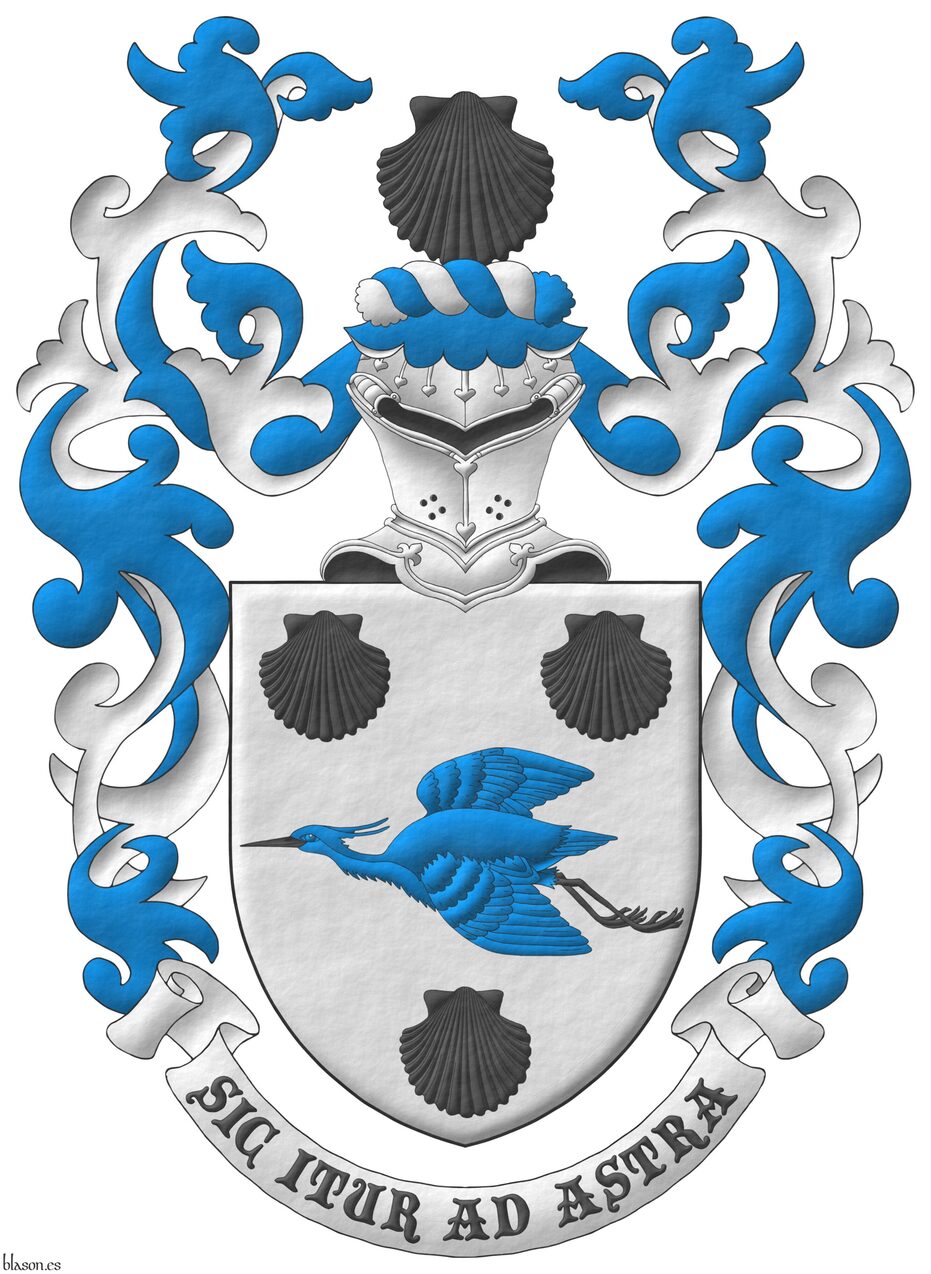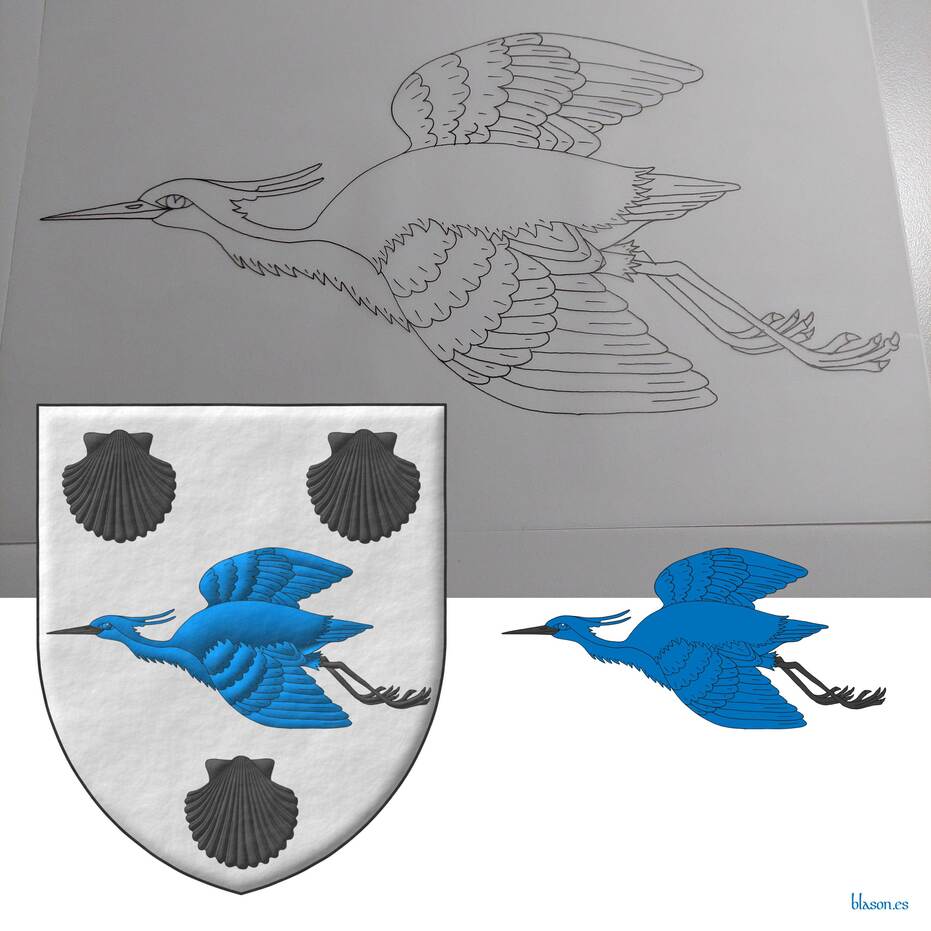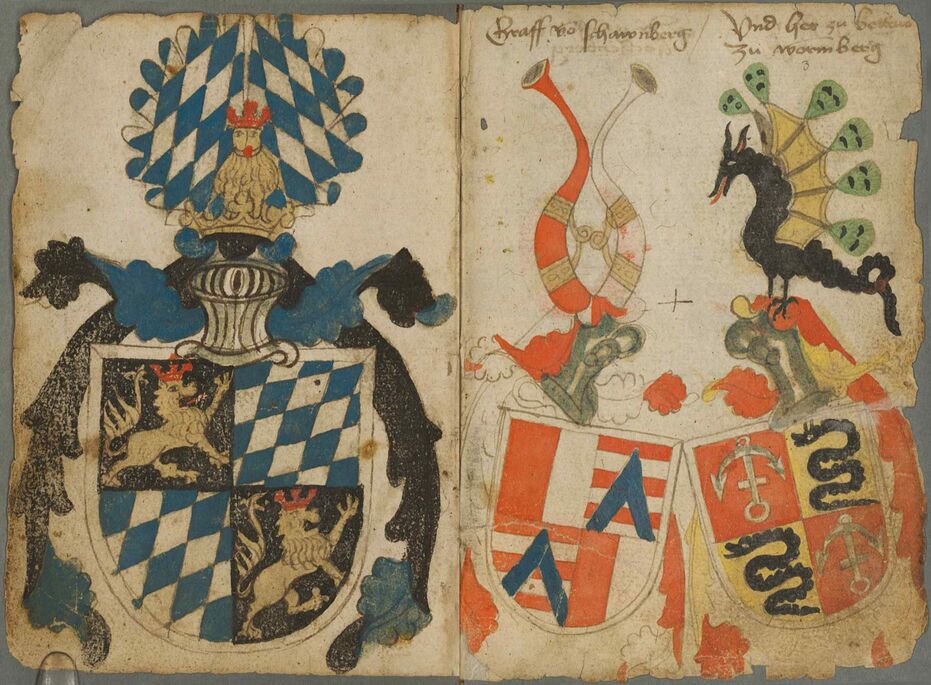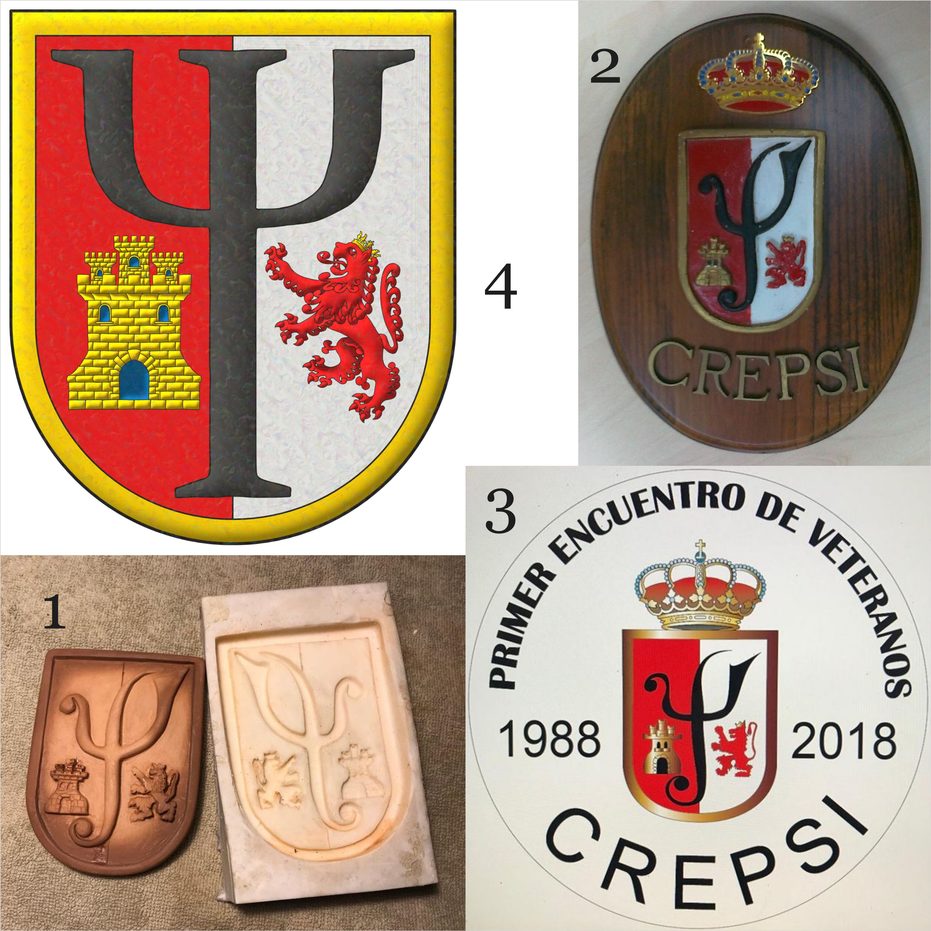
Crest and mantling of the family of Paul and Kari Herndon
Argent, a heron volant Azure, beaked and membered between three escallops Sable. Crest: Upon a helm with a wreath Argent and Azure, an escallop Sable. Mantling: Azure doubled Argent.
Coat of arms painted by me, highlighted with lights and shadows, contoured in Sable, with a pointed external shape and with a rough finish.
The canting arms of the family of Paul and Kari Herndon, based on the arms of their lineage, and emblazoned by me.
Blazon keywords: Argent, Azure, Sable, One, Three, Heron, Volant, Beaked, Membered, Between, Escallop, Crest and mantling, Crest, Upon (wreath), Helm, Wreath, Mantling and Doubled.
Style keywords: Outlined in sable, Illuminated, Pointed and Rough.
Classification: Personal, Canting, Interpreted, Boa and Coat of arms.
Bearer: Herndon, family of Paul and Kari.


Crest, mantling and motto of the family of Paul and Kari Herndon
Argent, a heron volant Azure, beaked and membered between three escallops Sable. Crest: Upon a helm with a wreath Argent and Azure, an escallop Sable. Mantling: Azure doubled Argent. Motto: «Sic itur ad astra».
Arms interpreted by me, highlighted with lights and shadows, outlined in Sable, with a pointed outer contour and with a rough finish.
Blazon keywords: Argent, Azure, Sable, One, Three, Heron, Volant, Beaked, Membered, Between, Escallop, Crest and mantling, Crest, Upon (wreath), Helm, Wreath, Mantling, Doubled and Motto.
Style keywords: Outlined in sable, Illuminated, Pointed and Rough.
Classification: Personal, Canting, Interpreted, Boa and Coat of arms.
Bearer: Herndon, family of Paul and Kari.


Family of Paul and Kari Herndon, hand-drawn
Argent, a heron volant Azure, beaked and membered between three escallops Sable.
Canting arms of the family of Paul and Kari Herndon, based on the arms of their lineage. The image combines a photograph of a drawing of a heron volant and a heron volant Azure, beaked and membered Sable, along with his coat of arms, all painted by me.
Blazon keywords: Argent, Azure, Sable, One, Three, Heron, Volant, Beaked, Membered, Between and Escallop.
Style keywords: Outlined in sable, Plain tincture, Illuminated and Pointed.
Classification: Personal, Canting, Interpreted, Boa, Hand-drawn, Collage and Photographic.
Bearer: Herndon, family of Paul and Kari.


![Ver [Ortenburg; 1473] en referencias bibliográficas. Libro abierto, hojas de plata, filo de oro, guardas de gules, tapas de sable.](../css/Libro.Bibliografia.png)
Ortenburg; 1473
Anonymous, «Ortenburg Armorial», written and illuminated by various individuals in Bavaria, between 1466 and 1473.
This armorial likely contains coats of arms and flags of the «cuaterniones», groups of four, each representing different social groups within the Holy Roman Empire. It also illustrates the heraldic emblems of most Bavarian princes, nobles, territories, bishoprics, and prince-bishops. Although its execution is somewhat rudimentary, it remains a valuable resource on the heraldry of southern Germany in the late 15th century.
By 1534, the manuscript had passed into the hands of the Counts of Ortenburg, near Passau, where heraldic emblems of the Ortenburg family and their ancestors were added. It remained with the family until 1953, when it was sold to the Bavarian State Library, where it is now preserved.
Bibliographical reference of century XV.
Classification: Armorial roll, Manuscript, German language and In color.
The author is unknown.
External resource:
Internal resources: Ortenburg1473.pdf Digital PDF version..


Crepsi, schema 1x3
Party per pale: 1 Gules, in base a castle triple-towered Or, port and windows Azure, and masoned Sable; 2 Argent, in base a lion rampant Gules, crowned Or; overall a psi letter sable; a diminished bordure Or.
Coat of arms of Crepsi, military psychology, former Central Military Region, Kingdom of Spain emblazoned by me. These arms were designed by my lieutenant colonel and friend Miguel Angel Nuñez Amador. The image shows three steps of my artwork: a) ratio, b) outlined, and c) plain colors and metals. The Castilian «filiera» is a diminished bordure; its width is usually 1/2 or 1/3 of the width of the bordure. The bordure itself is usually 1/6 of the width of the coat of arms. Therefore, the «filiera» is typically 1/(2×6) = 1/12 or 1/(3×6) = 1/18 of the width of the coat of arms.
Blazon keywords: Gules, Argent, Or, Azure, Sable, Party per pale, In base, Castle, Triple-towered, Port and windows, Masoned, Lion, Rampant, Crowned, Overall, Letter and Diminished bordure.
Style keywords: Ratio, Outlined, Outlined in sable, Plain tincture and Semi-circular.
Classification: Military, Interpreted, Schema, Boa and Coat of arms.
Bearer: Crepsi.


Crepsi, plain tincture

Party per pale: 1 Gules, in base a castle triple-towered Or, port and windows Azure, and masoned Sable; 2 Argent, in base a lion rampant Gules, crowned Or; overall a psi letter sable; a diminished bordure Or.
Arms emblazoned by me, in plain tinctures, contoured in Sable, with a semi-circular outer contour and with a texturized finishing.
Coat of arms of Crepsi, «Centro Regional de Psicología». These arms were designed by my lieutenant colonel and friend Miguel Angel Nuñez Amador, and in this image, they have been emblazoned by me.
Blazon keywords: Gules, Argent, Or, Azure, Sable, Party per pale, In base, Castle, Triple-towered, Port and windows, Masoned, Lion, Rampant, Crowned, Overall, Letter and Diminished bordure.
Style keywords: Outlined in sable, Plain tincture and Semi-circular.
Classification: Military, Interpreted, Boa and Coat of arms.
Bearer: Crepsi.


Crepsi
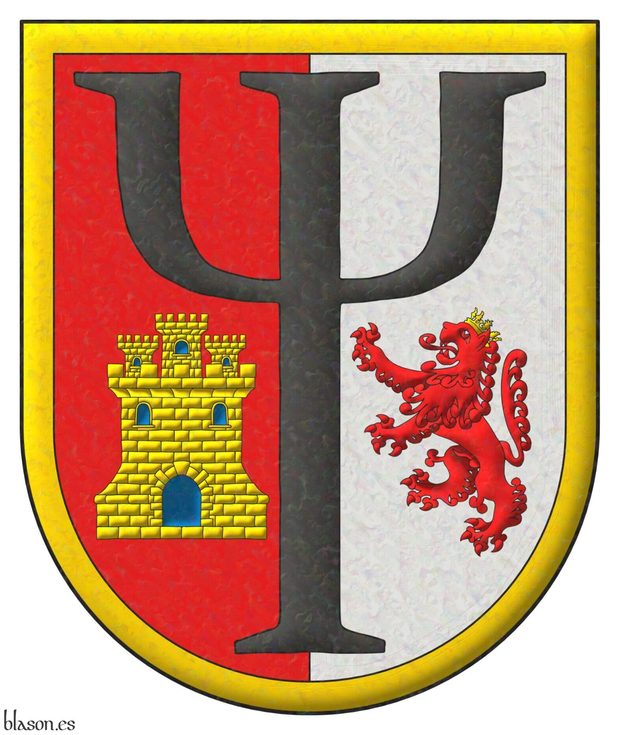
Party per pale: 1 Gules, in base a castle triple-towered Or, port and windows Azure, and masoned Sable; 2 Argent, in base a lion rampant Gules, crowned Or; overall a psi letter sable; a diminished bordure Or.
Escudo partido: 1o de gules, en punta un castillo de oro, aclarado de azur y mazonado de sable; 2o de plata, en punta un león rampante de gules, coronado de oro; brochante sobre la partición una letra psi de gules; una filiera de oro.
Coat of arms emblazoned by me, illuminated with lights and shadows, outlined in Sable, with a semi-circular outer contour and with a iridescent finishing.
Coat of arms of Crepsi, military psychology, former Central Military Region, Kingdom of Spain, where I was stationed during my military service. These arms were designed by my lieutenant colonel and friend Miguel Angel Nuñez Amador, and in this image, they have been emblazoned by me. The Crepsi was a pioneer in its functions: a) the identification of soldiers at psychological risk, among tens of thousands of soldiers, using advanced information systems, including Artificial Intelligence (an area where I contributed during my service in 1989), and b) the evaluation and individualized attention of soldiers at risk through mobile units. The Crepsi has provided trained personnel and methods that are being used for the psychological care of troops deployed to conflict zones and for the psychological care of civilians in massive humanitarian disasters such as terrorist attacks or plane crashes with hundreds of affected people.
Design rationale
The psi letter of psychology and the arms of the Central Military Region: Party per pale: 1 Gules, a castle triple-towered Or, port and windows Azure, and masoned Sable; 2 Argent, a lion rampant Gules, crowned Or. These two fields, in turn, Gules and Argent, charged with a castle triple-towered and a crowned lion, originate from the Kingdom of Castile and León. The diminished bordure is for difference.
Blazon keywords: Gules, Argent, Or, Azure, Sable, Party per pale, In base, Castle, Triple-towered, Port and windows, Masoned, Lion, Rampant, Crowned, Overall, Letter and Diminished bordure.
Style keywords: Outlined in sable, Illuminated, Semi-circular and Iridescent.
Classification: Military, Interpreted, Design rationale, Boa and Coat of arms.
Bearer: Crepsi.


Crepsi, comparation
Party per pale: 1 Gules, in base a castle triple-towered Or, port and windows Azure, and masoned Sable; 2 Argent, in base a lion rampant Gules, crowned Or; overall a psi letter sable; a diminished bordure Or.
Coat of arms of Crepsi, military psychology, former Central Military Region, Kingdom of Spain, emblazoned by me, where I was stationed during my military service. In the image: 1988, the original mold (1) with which the first 6 coats of arms were made; one of them is now in my office (2); the design of the badge for the 1st meeting of veterans (3), all of which were designed and made by my lieutenant colonel and friend Miguel Angel Nuñez Amador; and finally, the coat of arms of Crepsi emblazoned by me (4).
Blazon keywords: Gules, Argent, Or, Azure, Sable, Party per pale, In base, Castle, Triple-towered, Port and windows, Masoned, Lion, Rampant, Crowned, Overall, Letter and Diminished bordure.
Style keywords: Outlined in sable, Illuminated and Semi-circular.
Classification: Military, Interpreted, Compare, Boa and Coat of arms.
Bearer: Crepsi.

Continue with: Crown of Crepsi.
-
Language
-
Categories of heraldry
-
Divisions of the field
- Without divisions
- Party per pale
- Party per fess
- Party per bend
- Party per bend sinister
- Tierce
- Tierce sinister
- Tierced per pale
- Tierced per fess
- Tierced per bend
- Tierced pallwise inverted
- Quarterly
- Quarterly per saltire
- Gyronny
- Party per fess, the chief per pale
- Party per pale, the sinister per fess
- Party per fess, the base per pale
- Party per pale, the dexter per fess
- Chapé
- Chaussé
- Embrassé
- Contre-embrassé
- Party per chevron
- Enté
- Enté en point
- Flanched
-
Metals
-
Colours
-
Furs
-
Other tinctures
-
Ordinaries and sub-ordinaries
-
Diminutives of the ordinaries
-
Geometric charges
-
Composite ordinaries
-
Inanimate charges from Nature
Atom, Crescent, Diamond, Emerald, Estoile, Increscent, Lightning flash, Moon, Mount, Mullet, Mullet of four points, Orbital, Plough of Ursa Major, Rainbow, Ray of the sun, River, Sea, Snowflake, Sun, Sun in splendour, Sun of May, Trimount, Water and Wave.
-
Vegetal charges from Nature
Acorn, Apple, Apple tree, Ash, Bluebonnet, Camellia, Chrysanthemum, Cinquefoil, Cornflower, Dogwood flower, Double rose, Elm, Fleur de lis, Flower, Gourd, Holm oak, Hop cone, Kapok tree, Laurel, Lily, Linden, Lotus flower, Madonna lily, Mexican cedar tree, Oak, Olive tree, Palm tree, Plantain plant, Pomegranate, Poplar leaf, Rose, Shamrock, Sunflower, Thistle, Tree, Tulip, Vine and Wheat.
-
Animal charges from Nature
Badger, Bald eagle, Barbel, Barn owl, Bear, Beaver, Beetle, Bighorn sheep, Blackbird, Boar, Brach hound, Bull, Doe, Dog, Dolphin, Dove, Eagle, Elephant, Falcon, Female figure, Fish, Flame, Fly, Fox, Frog, Goat, Goldfinch, Goose, Heron, Horse, Hummingbird, Jaguar, Lark, Leopard, Lion, Lion passant, Lion rampant guardant, Lioness, Lynx, Male figure, Martlet, Merino ram, Owl, Panther, Parrot, Peacock, Pelican, Pelican in her piety, Puffin, Quetzal, Raven, Roe deer, Rooster, Savage, Seagull, Serpent, She-wolf, Stag, Starling, Talbot, Tyger, Vulture, Warren hound and Wolf.
-
Parts of natural charges
Arm, Beak, Branch, Caboshed, Chest, Claw, Covert, Dorsal fin, Eagle claw, Ermine spot, Escallop, Feather, Foot (palmiped), Foreleg, Forepaw, Hand, Head, Heart, Hoof, Leaf, Neck, Ostrich feather, Palm frond, Paw, Roe deers' attires, Shoulder, Sprig, Stags' attires, Stem, Swallow-tail, Tail, Tail addorsed, Tail fin, Talon, Tooth, Trunk, Trunk (elephant), Two hands clasped, Two wings in vol, Udder, Wheat spike, Wing and Wrist.
-
Artificial charges
Ace of spades, Anchor, Anvil, Arch, Arm vambraced, Armillary sphere, Arrow, Axe, Bell, Bell tower, Beret, Bonfire, Book, Bookmark, Bow, Branding iron, Bridge, Broken, Buckle, Cannon, Cannon dismounted, Cannon port, Canopy roof, Carbuncle, Castle, Celtic Trinity knot, Chain, Chess rooks, Church, Clarion, Clay pot, Closed book, Club, Column, Comb, Compass rose, Conductor's baton, Cord, Covered cup, Crozier, Crucible, Cuffed, Cup, Cyclamor, Dagger, Double vajra, Drum, Ecclesiastical cap, Fanon, Federschwert, Fleam, Four crescents joined millsailwise, Galician granary, Garb, Gauntlet, Geometric solid, Grenade, Halberd, Hammer, Harp, Host, Hourglass, Key, Key ward, Knight, Knot, Lantern, Letter, Line, Loincloth, Menorah, Millrind, Millstone, Millwheel, Monstrance, Mortar, Mullet of six points pierced, Nail, Non-classic artifact, Norman ship, Number, Oar, Oil lamp, Open book, Page, Pair of scales, Parchment, Pestle, Piano, Pilgrim's staff, Plough share, Polish winged hussar, Port, Portcullis, Potent, Quill, Ribbon, Rosette of acanthus leaves, Sabre, Sackbut, Sail, Scroll, Scythe, Sheaf of tobacco, Ship, Skirt, Spear, Spear's head, Stairway, Star of David, Step, Sword, Symbol, Tetrahedron, Torch, Tower, Trident, Trumpet, Turret, Two-handed sword, Wagon-wheel, Water-bouget, Wheel, Winnowing fan and With a turret.
-
Immaterial charges
Angel, Archangel, Basilisk, Dragon, Dragon's head, Garuda, Golden fleece, Griffin, Heart enflamed, Justice, Mermaid, Our Lady of Mercy, Ouroboros, Paschal lamb, Pegasus, Phoenix, Sacred Heart of Jesus, Saint George, Sea-griffin, Trinity, Triton, Unicorn, Winged hand and Wyvern.
-
External elements
-
Heraldic creations
-
References
-
Formats
-
Keywords on this page
Port and windows, Between, Pointed, Armorial roll, Azure, Bibliography, Boa, Overall, Wreath, Castle, Upon (wreath), Crest, Collage, Crowned, Crepsi, Triple-towered, Outlined in sable, Doubled, In base, Coat of arms, Diminished bordure, Heron, Personal, Gules, Herndon, family of Paul and Kari, Illuminated, Interpreted, Mantling, Letter, Lion, Masoned, Semi-circular, Membered, Military, Or, Canting, Party per pale, Beaked, Argent, Rampant, Rough, Sable, Crest and mantling, Plain tincture, Three, One, Escallop, Volant and Helm.


